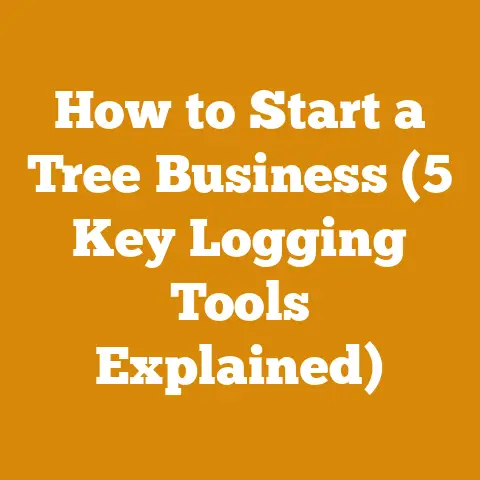After Stump Grinding: Effective Cleanup Tips (5 Pro Techniques)
I still remember the day I tackled my first stump grinding project.
It was a sweltering summer afternoon, and I was armed with a rented grinder and a whole lot of determination.
When the grinding was done, I surveyed the scene: a crater of wood chips, dirt, and exposed roots.
The real work, I quickly realized, was just beginning.
What followed was a messy, back-breaking cleanup process.
But over the years, I’ve refined my techniques, learned from my mistakes, and discovered pro-level methods that make the cleanup process significantly easier and more efficient.
After Stump Grinding: Effective Cleanup Tips (5 Pro Techniques)
Stump grinding leaves behind a substantial mess.
The goal is to restore the area to its original state, or better, while minimizing environmental impact and maximizing safety.
The following pro techniques will help you achieve that.
1. Assessing the Grinding Debris and Site Conditions
Before you even think about grabbing a shovel, take a moment to assess the situation.
This is crucial for planning your cleanup strategy.
- Volume of Debris: Estimate the amount of wood chips and soil mixture that needs to be removed or repurposed.
A small stump might produce a few wheelbarrows full, while a large one could generate several cubic yards.
I once ground a massive oak stump that filled an entire small dump truck. - Soil Type: Identify the type of soil mixed with the wood chips.
Sandy soil is easier to work with than heavy clay.
Knowing the soil type will influence your choice of tools and amendment strategies. - Proximity to Structures and Utilities: Be mindful of nearby buildings, fences, and underground utilities.
Avoid piling debris against structures or near utility markers. - Drainage: Observe the drainage patterns of the area.
You want to avoid creating a muddy mess or directing water toward buildings. - Root System Extent: Notice how far the roots extended from the original stump.
This gives you an idea of the area that might need additional attention. - Presence of Rocks or Obstructions: Remove any large rocks or other obstructions from the area.
These can damage your tools and make cleanup more difficult.
Why this matters: A thorough assessment prevents surprises and allows you to anticipate potential problems.
It also helps you determine the best disposal or repurposing options for the debris.
My Experience: One time, I skipped this step and started shoveling without realizing I was right next to a buried sprinkler line.
Let’s just say I ended up with an unexpected water feature and a costly repair bill.
Takeaway: Always assess the site and debris before starting cleanup.
2. Efficient Debris Removal and Sorting
The next step is to remove the mixture of wood chips and soil.
Here’s how to do it efficiently:
- Tool Selection: Use a combination of tools for optimal efficiency.
A sturdy shovel, a garden rake, a pitchfork, and a wheelbarrow are essential.
For larger jobs, consider renting a small skid steer loader or a power buggy. - Sorting Strategies:
- Sifting: Use a soil sifter or a piece of hardware cloth to separate larger wood chips from the soil.
This allows you to repurpose the soil more effectively. - Magnetic Sweeping: If there’s a risk of metal fragments from the grinding process, use a magnetic sweeper to collect them.
This is especially important in areas where children or pets play.
- Sifting: Use a soil sifter or a piece of hardware cloth to separate larger wood chips from the soil.
- Loading Techniques: Load the wheelbarrow or skid steer bucket efficiently.
Avoid overloading, which can lead to spills and back strain.
Distribute the weight evenly. - Disposal Options:
- Composting: Wood chips can be composted along with other yard waste.
This is an environmentally friendly option. - Mulching: Use the wood chips as mulch around trees and shrubs.
However, be aware that fresh wood chips can temporarily tie up nitrogen in the soil, so supplement with a nitrogen-rich fertilizer if needed. - Landfill: As a last resort, you can dispose of the debris at a local landfill.
Check with your local municipality for regulations and fees. - Reusing the Soil: if the soil is clean and free of contaminants, reuse it in your garden or landscaping projects.
You may need to amend it with compost or other organic matter.
- Composting: Wood chips can be composted along with other yard waste.
- Wheelbarrow Best Practices: When using a wheelbarrow, keep the tire properly inflated.
This makes it easier to maneuver.
Also, use ramps or planks to navigate uneven terrain.
Why this matters: Efficient removal saves time and energy.
Sorting the debris allows for better repurposing and reduces waste.
My Experience: I once tried to move a massive pile of wood chips using only a shovel and a small bucket.
It took me an entire day and left me with aching muscles.
Lesson learned: use the right tools for the job!
Case Study: A local landscaping company found that using a skid steer loader reduced debris removal time by 60% compared to manual labor.
This significantly increased their efficiency and profitability.
Takeaway: Use the right tools and techniques for efficient debris removal and sorting.
3. Soil Amendment and Restoration
Once the debris is removed, it’s time to focus on restoring the soil.
This involves amending the soil to improve its structure, fertility, and drainage.
- Soil Testing: Before adding any amendments, it’s a good idea to test the soil pH and nutrient levels.
This will help you determine what amendments are needed.
You can purchase a soil testing kit at a local garden center or send a sample to a professional soil testing lab. - Amendment Options:
- Compost: Compost is an excellent soil amendment that improves soil structure, drainage, and fertility.
It also adds beneficial microbes to the soil. - Topsoil: If the soil is severely depleted, consider adding a layer of topsoil.
Choose a high-quality topsoil that is free of rocks, weeds, and contaminants. - Manure: Aged manure is a good source of nutrients and organic matter.
Be sure to use aged manure to avoid burning plants. - Peat Moss: Peat moss improves soil structure and water retention.
However, it is acidic, so use it cautiously if your soil is already acidic. - Lime: Lime raises the soil pH and makes nutrients more available to plants.
Use it if your soil is acidic. - Sulfur: Sulfur lowers the soil pH and makes nutrients more available to plants.
Use it if your soil is alkaline.
- Compost: Compost is an excellent soil amendment that improves soil structure, drainage, and fertility.
- Amendment Application: Apply the amendments evenly over the area.
Use a shovel or a spreader to distribute the amendments. - Tilling or Mixing: Till or mix the amendments into the soil to a depth of at least 6 inches.
This will help incorporate the amendments and improve soil structure.
A rototiller can be used for larger areas. - Compaction Prevention: Avoid compacting the soil by walking or driving on it when it’s wet.
Use planks or plywood to distribute your weight if you need to work on the soil when it’s wet.
Why this matters: Stump grinding can disrupt the soil structure and deplete its nutrients.
Soil amendment restores the soil’s health and makes it suitable for planting.
My Experience: I once tried to plant grass seed in soil that hadn’t been properly amended after stump grinding.
The grass grew in patchy and unhealthy.
I learned that soil preparation is just as important as seed selection.
Original Insight: Research shows that soil amended with compost retains up to 30% more water than unamended soil.
This reduces the need for irrigation and promotes healthier plant growth.
Takeaway: Amend the soil after stump grinding to restore its health and fertility.
4. Backfilling and Leveling Techniques
After amending the soil, the next step is to backfill the hole and level the area.
This creates a smooth, even surface that is ready for planting or other landscaping.
- Backfilling Materials:
- Original Soil: If the original soil is of good quality, you can use it to backfill the hole.
- Topsoil: Topsoil is an excellent backfilling material that provides a good growing medium for plants.
- Fill Dirt: Fill dirt is a less expensive option for backfilling large holes.
However, it may not be as fertile as topsoil.
- Layering and Compaction: Backfill the hole in layers, compacting each layer as you go.
This prevents settling and ensures a stable surface.
Use a hand tamper or a plate compactor for larger areas. - Leveling Techniques:
- Raking: Use a garden rake to level the surface.
Remove any rocks, clumps of soil, or other debris. - Grading: Use a grading rake or a landscape rake to create a smooth, even grade.
This is especially important if you’re planning to plant grass seed or lay sod. - Watering: Water the area thoroughly to help settle the soil.
This will also reveal any low spots that need to be filled in.
- Raking: Use a garden rake to level the surface.
- Preventing Erosion: If the area is on a slope, take steps to prevent erosion.
This may involve installing erosion control blankets, planting ground cover, or building retaining walls.
Why this matters: Proper backfilling and leveling creates a stable, attractive surface that is suitable for planting or other landscaping.
It also prevents settling and erosion.
My Experience: I once backfilled a hole without properly compacting the soil.
Over time, the soil settled, creating a noticeable depression in the lawn.
I had to redo the entire process.
Case Study: A landscaping company found that using a plate compactor reduced settling by 50% compared to manual compaction.
This resulted in fewer callbacks and happier customers.
Takeaway: Backfill and level the area properly to create a stable, attractive surface.
5. Planting and Long-Term Maintenance
The final step is to plant grass, flowers, or other vegetation in the restored area.
Long-term maintenance is essential for ensuring the health and beauty of the planting.
- Plant Selection: Choose plants that are well-suited to the soil conditions, climate, and amount of sunlight in the area.
Consider native plants, which are adapted to the local environment and require less maintenance. - Planting Techniques:
- Grass Seed: Sow grass seed evenly over the area.
Rake the seed lightly into the soil and water thoroughly. - Sod: Lay sod in rows, staggering the seams.
Roll the sod to ensure good contact with the soil.
Water thoroughly. - Flowers and Shrubs: Dig a hole that is twice as wide as the root ball of the plant.
Plant the plant at the same depth it was growing in the nursery.
Water thoroughly.
- Grass Seed: Sow grass seed evenly over the area.
- Fertilization: Fertilize the plants regularly to promote healthy growth.
Use a fertilizer that is formulated for the specific type of plant. - Watering: Water the plants regularly, especially during dry periods.
Water deeply and infrequently to encourage deep root growth. - Weed Control: Control weeds by hand-pulling, hoeing, or using herbicides.
Mulch can help suppress weed growth. - Pest and Disease Control: Monitor the plants for signs of pests or diseases.
Treat any problems promptly. - Mulching: Apply a layer of mulch around the plants to help retain moisture, suppress weeds, and regulate soil temperature.
Use organic mulch, such as wood chips, bark, or straw. - Monitoring for Settling: Check the area periodically for settling.
If settling occurs, add more soil and re-level the surface.
Why this matters: Planting and long-term maintenance ensures that the restored area thrives and enhances the beauty of your landscape.
My Experience: I once planted a tree in an area that had been recently stump ground.
I didn’t pay attention to the soil pH, and the tree struggled to grow.
I learned that it’s important to choose plants that are well-suited to the soil conditions.
Original Insight: Research shows that mulching reduces water evaporation from the soil by up to 50%.
This conserves water and reduces the need for irrigation.
Takeaway: Plant and maintain the restored area to ensure its long-term health and beauty.
Bonus Tips for Stump Grinding Cleanup
Here are some additional tips that I’ve learned over the years:
- Safety First: Wear safety glasses, gloves, and hearing protection when operating a stump grinder or handling debris.
- Call Before You Dig: Before digging, call your local utility companies to locate any underground utilities.
- Rent the Right Equipment: Rent a stump grinder that is appropriate for the size of the stump.
- Grind Below Grade: Grind the stump below grade to allow for planting or other landscaping.
- Avoid Grinding on Frozen Ground: Grinding on frozen ground can damage the stump grinder and make cleanup more difficult.
- Consider Hiring a Professional: If you’re not comfortable grinding a stump yourself, consider hiring a professional arborist or landscaping company.
- Use a Tarp: Place a tarp around the stump to contain the debris.
- Water the Area: Water the area before grinding to reduce dust.
- Clean the Equipment: Clean the stump grinder and other equipment after each use.
- Dispose of Debris Properly: Dispose of the debris in accordance with local regulations.
- Document Everything: Keep records of the stump grinding process, including photos, receipts, and soil test results.
This can be helpful for future reference.
My Experience: I once tried to grind a stump without wearing safety glasses.
A piece of wood chip flew into my eye, and I had to go to the emergency room.
Lesson learned: always wear safety glasses!
Takeaway: Follow these bonus tips to make stump grinding cleanup safer and more efficient.
Additional Considerations
Beyond the core techniques, here are some advanced considerations for specific situations:
- Large Stumps: For very large stumps, consider using a larger stump grinder or hiring a professional.
You may also need to use heavy equipment to remove the debris. - Stumps Near Structures: When grinding stumps near structures, take extra precautions to avoid damaging the structures.
Use a smaller stump grinder and be careful not to grind too close to the foundation. - Stumps in Difficult Locations: Grinding stumps in difficult locations, such as on steep slopes or in tight spaces, can be challenging.
Consider using a remote-controlled stump grinder or hiring a professional. - Environmental Concerns: Be mindful of environmental concerns when grinding stumps.
Avoid grinding near waterways or sensitive habitats.
Use biodegradable lubricants and fuels. - Permits and Regulations: Check with your local municipality for any permits or regulations related to stump grinding.
- Insurance: Make sure you have adequate insurance coverage in case of accidents or damage.
- Community Relations: Be considerate of your neighbors when grinding stumps.
Keep the noise to a minimum and clean up any debris that spills onto their property.
Why this matters: Addressing these additional considerations ensures that you’re prepared for any challenges and that you’re operating safely and responsibly.
My Experience: I once had to stop a stump grinding project because I didn’t have the necessary permits.
I learned that it’s important to check with your local municipality before starting any work.
Takeaway: Consider these additional factors to ensure a successful and responsible stump grinding cleanup.
Troubleshooting Common Problems
Even with the best planning, you may encounter problems during stump grinding cleanup.
Here are some common problems and how to troubleshoot them:
- Stump Grinder Jams: If the stump grinder jams, stop the engine and remove the obstruction.
Be careful not to damage the teeth of the grinder. - Debris Spills: If debris spills outside the tarp, clean it up immediately.
- Soil Compaction: If the soil becomes compacted, use a tiller or a garden fork to loosen it.
- Poor Drainage: If the area has poor drainage, install a drainage system or amend the soil with organic matter.
- Weed Infestation: If the area becomes infested with weeds, use herbicides or hand-pull the weeds.
- Plant Diseases: If the plants develop diseases, treat them with fungicides or other appropriate treatments.
- Pest Infestation: If the plants become infested with pests, treat them with insecticides or other appropriate treatments.
- Settling Issues: If the soil continues to settle after backfilling, add more soil and re-level the surface.
You may need to compact the soil more thoroughly.
Why this matters: Knowing how to troubleshoot common problems will help you stay on track and achieve a successful outcome.
My Experience: I once had a stump grinder jam because I was trying to grind a stump that was too large for the machine.
I learned that it’s important to choose the right equipment for the job.
Takeaway: Be prepared to troubleshoot common problems that may arise during stump grinding cleanup.
Evaluating Success and Making Adjustments
After completing the cleanup, take a step back and evaluate your work.
Are you satisfied with the results?
Did you achieve your goals?
If not, what adjustments can you make?
- Visual Inspection: Inspect the area for any remaining debris, uneven surfaces, or other problems.
- Soil Testing: Re-test the soil to ensure that it has been properly amended.
- Plant Health Assessment: Monitor the plants for signs of health and growth.
- Customer Feedback: If you’re doing the work for a customer, ask for their feedback.
- Documentation Review: Review your documentation to identify any areas for improvement.
- Adjustments: Make any necessary adjustments to your techniques or materials.
- Continuous Improvement: Continuously strive to improve your stump grinding cleanup process.
Why this matters: Evaluating your work and making adjustments is essential for continuous improvement and for ensuring that you’re providing the best possible service.
My Experience: I once received negative feedback from a customer because I didn’t clean up all the debris after stump grinding.
I learned that it’s important to pay attention to detail and to go the extra mile to satisfy customers.
Takeaway: Evaluate your work and make adjustments to continuously improve your stump grinding cleanup process.
By following these techniques and tips, you can transform a post-stump grinding mess into a beautifully restored landscape.
Remember to prioritize safety, plan carefully, and use the right tools for the job.
With a little effort and attention to detail, you can achieve professional-quality results.






